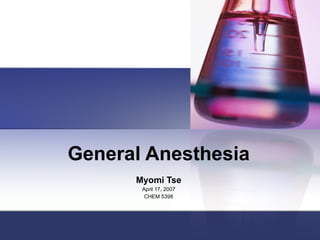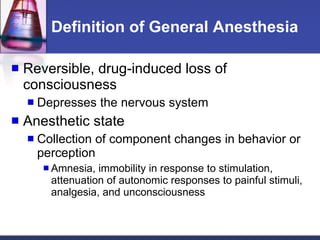General anesthesia
- 1. General Anesthesia Myomi Tse April 17, 2007 CHEM 5398
- 2. Overview of Discussion Historical Perspective What is General Anesthesia? Definition Principles of Surgical Anesthesia Hemodynamic and Respiratory Effects Hypothermia Nausea and Vomiting Emergence Mechanisms of Anesthesia Early Ideas Cellular Mechanisms Structures Molecular Actions: GABA A Receptor Mechanism of Propofol (Diprivan ? ) Metabolism and Toxicity Adverse Affects of Propofol Remaining Questions Concerning the GABA A Receptor Latest Discoveries and Current Events
- 3. Historical Perspective Original discoverer of general anesthetics Crawford Long: 1842, ether anesthesia Chloroform introduced James Simpson: 1847 Nitrous oxide Horace Wells 19 th Century physician administering chloroform
- 4. Historical Perspective William Morton October 16, 1846 Gaseous ether Public demonstration gained world-wide attention Public demonstration consisted of an operating room, Ą° ether dome, Ąą where Gilbert Abbot underwent surgery in an unconscious state at the Massachusetts General Hospital Ether no longer used in modern practice, yet considered to be the first Ą°idealĄą anesthetic
- 5. Historical Perspective Cyclopropane: 1929 Most widely used general anesthetic for the next 30 years Halothane: 1956 Team effort between the British Research Council and chemists at Imperial Chemical Industries Preferred anesthetic of choice Thiopental: Intravenous anesthetic
- 6. Definition of General Anesthesia Reversible, drug-induced loss of consciousness Depresses the nervous system Anesthetic state Collection of component changes in behavior or perception Amnesia, immobility in response to stimulation, attenuation of autonomic responses to painful stimuli, analgesia, and unconsciousness
- 7. Principles of General Anesthesia Minimizing the potentially harmful direct and indirect effects of anesthetic agents and techniques Sustaining physiologic homeostasis during surgical procedures Improving post-operative outcomes
- 8. The Body and General Anesthesia Hemodynamic effects: decrease in systemic arterial blood pressure Respiratory effects: reduce or eliminate both ventilatory drive and reflexes maintaining the airway unblocked Hypothermia: body temperature < 36 ?C Nausea and Vomiting Chemoreceptor trigger zone Emergence Physiological changes
- 9. Mechanism Early Ideas Unitary theory of anesthesia Anesthesia is produced by disturbance of the physical properties of cell membranes Problematic: theory fails to explain how the proposed disturbance of the lipid bilayer would result in a dysfunctional membrane protein Inhalational and intravenous anesthetics can be enantio-selective in their action Focus on identifying specific protein binding sites for anesthetics
- 10. Cellular Mechanism Intravenous Anesthetics Substantial effect on synaptic transmission Smaller effect on action-potential generation or propagation Produce narrower range of physiological effects Actions occur at the synapse Effects the post-synaptic response to the released neurotransmitter Enhances inhibitory neurotransmission
- 11. Structures Intravenous Inhalational Propofol Etomidate Ketamine Halothane Isoflurane Sevoflurane
- 12. Molecular Actions: GABA A Receptor Ligand-gated ion channels Chloride channels gated by the inhibitory GABA A receptor GABA A receptor mediates the effects of gamma-amino butyric acid (GABA), the major inhibitory neurotransmitter in the brain GABA A receptor found throughout the CNS Most abundant, fast inhibitory, ligand-gated ion channel in the mammalian brain Located in the post-synaptic membrane
- 13. Molecular Actions: GABA A Receptor GABA A receptor is a 4-transmembrane (4-TM) ion channel 5 subunits arranged around a central pore: 2 alpha, 2 beta, 1 gamma Each subunit has N-terminal extracellular chain which contains the ligand-binding site 4 hydrophobic sections cross the membrane 4 times: one extracellular and two intracellular loops connecting these regions, plus an extracellular C-terminal chain
- 14. Molecular Action: GABA A Receptor
- 15. Molecular Action: GABA A Receptor Receptor sits in the membrane of its neuron at the synapse GABA , endogenous compound, causes GABA to open Receptor capable of binding 2 GABA molecules, between an alpha and beta subunit Binding of GABA causes a conformational change in receptor Opens central pore Chloride ions pass down electrochemical gradient Net inhibitory effect, reducing activity of the neuron
- 16. Mechanism of Propofol Action of anesthetics on the GABA A receptor Binding of anesthetics to specific sites on the receptor protein Proof of this mechanism is through point mutations Can eliminate the effects of the anesthetic on ion channel function General anesthetics do not compete with GABA for its binding on the receptor
- 17. Mechanism of Propofol Inhibits the response to painful stimuli by interacting with beta 3 subunit of GABA A receptor Sedative effects of Propofol mediated by the same GABA A receptor on the beta 2 subunit Indicates that two components of anesthesia can be mediated by GABA A receptor Action of Propofol Positive modulation of inhibitory function of GABA through GABA A receptors
- 18. Mechanism of Propofol Parenteral anesthetic Small, hydrophobic, substituted aromatic or heterocyclic compound Propofol partitions into lipophilic tissues of the brain and spinal cord Produces anesthesia within a single circulation time
- 19. Metabolism and Toxicity Recovery after doses/infusion of Propofol is fast Half-life is Ą°context-sensitiveĄą Based on its own hydrophobicity and metabolic clearance, PropofolĄŊs half-life is 1.8 hours Accounts for the quick 2-4 minute distribution to the entire body Expected for a highly lipid-soluble drug Anesthetic of choice
- 20. Metabolism and Toxicity Propofol is extensively metabolized 88% of an administered dose appearing in the urine Eliminated by the hepatic conjugation of the inactive glucuronide metabolites which are excreted by the kidney
- 21. Adverse Effects of Propofol Hypotension Arrhythmia Myocardial ischemia Restriction of blood supply Confusion Rash Hyper-salivation Apnea
- 22. Remaining Questions At the molecular level, where are the binding sites on the GABA A receptor? Which neuronal structures are most important for the anesthetic end points of interest?
- 23. Latest Discoveries: Implications for the Medicinal Chemist Explosion of new information on the structure and function of GABA A receptors Cloning and sequencing multiple subunits Advantageous: large number of different subunits (16) allows for a great variety of different types of GABA A receptors that will likely differ in drug sensitivity Propofol delivery technology Mechanically driven pumps Computer-controlled infusion systems Ą° target controlled infusionĄą (TCI)
- 24. Latest Discoveries: Implications for the Medicinal Chemist Findings collectively enhance the understanding on the mechanism of action of Propofol Allows the medicinal chemist to rationally design analogues with better pharmacological profiles
- 25. Current News March 30, 2007 The Wall Street Journal: Ą°FDA Wants More Research on Anesthesia Risk to KidsĄą Anesthesia can be harmful to the developing brain, studies on animals suggest, raising concerns about potential risks in putting young children under for surgery Prolonged changes in behavior; memory and learning impairments Relevance of the animal findings to pediatric patients is unknown
- 26. Thank you!

























